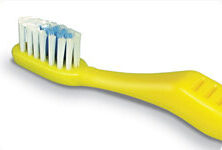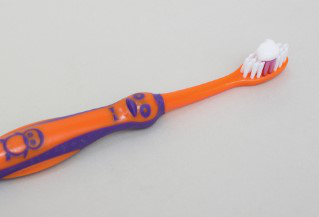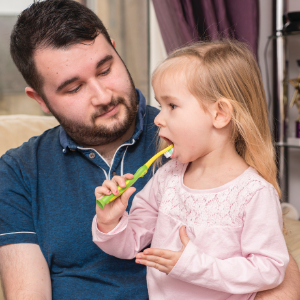Toothbrushing guide – film
Read the transcript for this film ‘toothbrushing guide‘
From the moment their first tooth appears, Brush teeth and gums at least twice daily, in the morning and last thing at night. Use toothpaste containing at least 1,000 parts per million (ppm) fluoride. Find out more with our toothbrushing tips.
Stage 1 – baby
At first your baby may find it a bit strange but will soon get used to the soothing feeling.
Find a place that is comfortable and safe for baby. Always supervise toothbrushing and never leave a baby or small child alone with a toothbrush or toothpaste.
Which toothbrush?
Use a toothbrush with a small head and soft bristles.

Which toothpaste?
At home, encourage healthy habits and use a toothbrush and toothpaste containing at least 1,000 parts per million (ppm) fluoride.
For children under 3 years of age use a smear of toothpaste on the brush.
Toothbrushing positions
- on your knee
- on a changing mat
- in a baby chair or high chair
- sitting in a pram or buggy
- in the bath.
When to brush
- pick a time that is convenient to you
- think of your child’s daily routine, perhaps at playtime or bath time
- eventually you can move on to a morning and night time routine.
Stage 2 – toddler
A growing child needs teeth to smile and eat with, and to give them confidence. Establishing a good oral care routine from early childhood is important and can be supported by parents and carers.
Which toothbrush?
Use a toothbrush with a small head and soft bristles.
Which toothpaste?
For children aged 3 years and above, use a pea sized amount of toothpaste containing at least 1,000 parts per million (ppm) fluoride.

When to brush
Brush teeth and gums at least twice daily, in the morning and last thing at night.
As more teeth come through, it is important to develop a system of brushing that ensures that all surfaces of the teeth are brushed thoroughly each time.
Stage 3 – pre school
Children should be supervised whilst brushing until they can brush independently.
Children should be encouraged to do some of the brushing themselves so that they develop toothbrushing skills. Remember to encourage your child. Praise will often get results.
Which toothbrush?
Use a toothbrush with a small head and soft bristles.

Which toothpaste?
For children aged three years and above, use a pea-sized amount of toothpaste
Use toothpaste containing at least 1,000 parts per million (ppm) fluoride.
When to brush
Brush teeth and gums at least twice daily, in the morning and last thing at night.
It is preferable to wait at least 30 minutes following eating or drinking, however we appreciate this is not always possible, it is always better to brush your teeth than not.
Establishing a routine is key.
